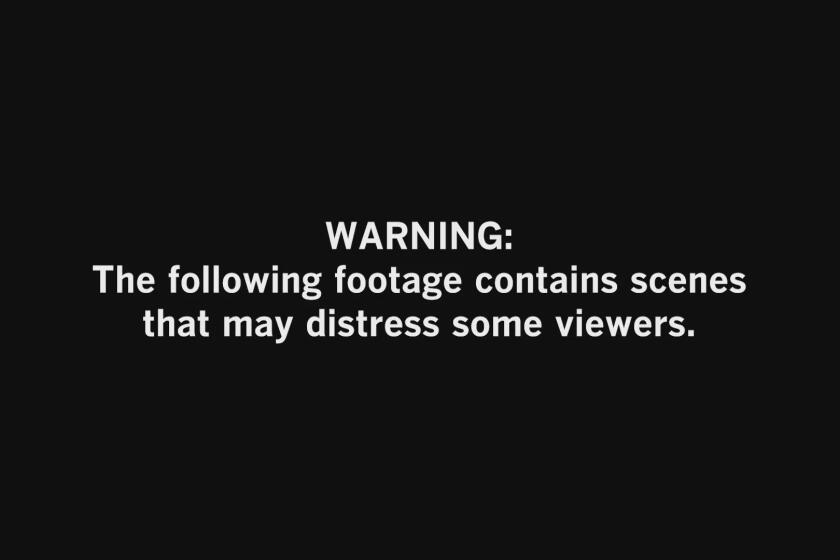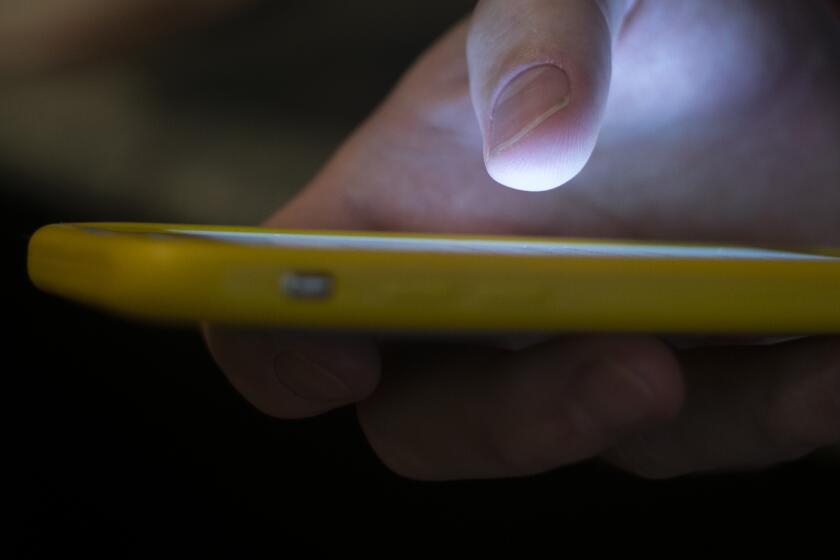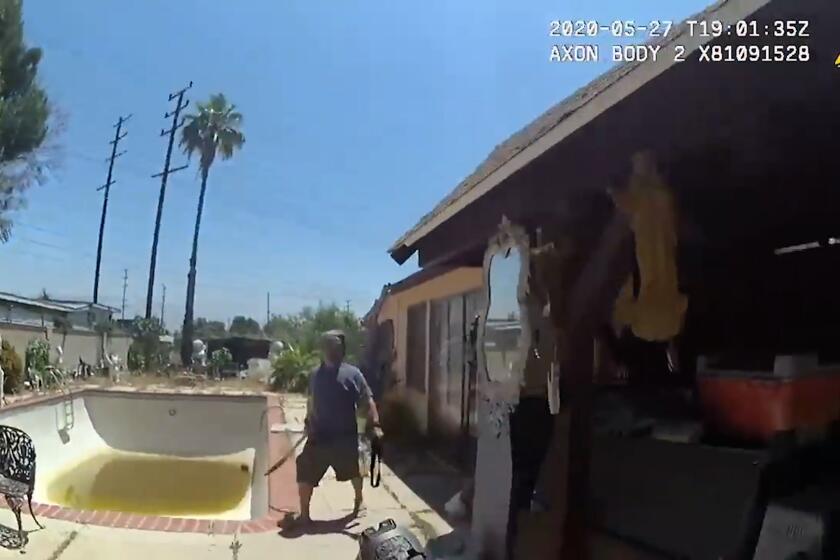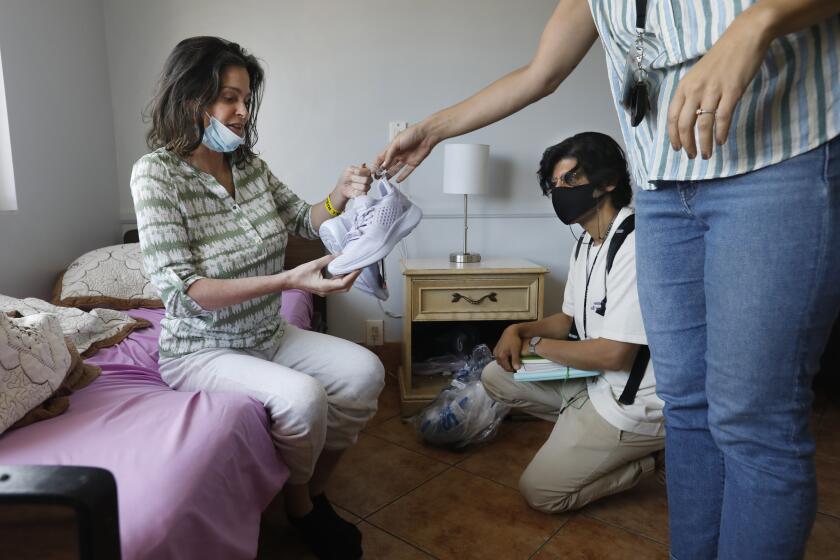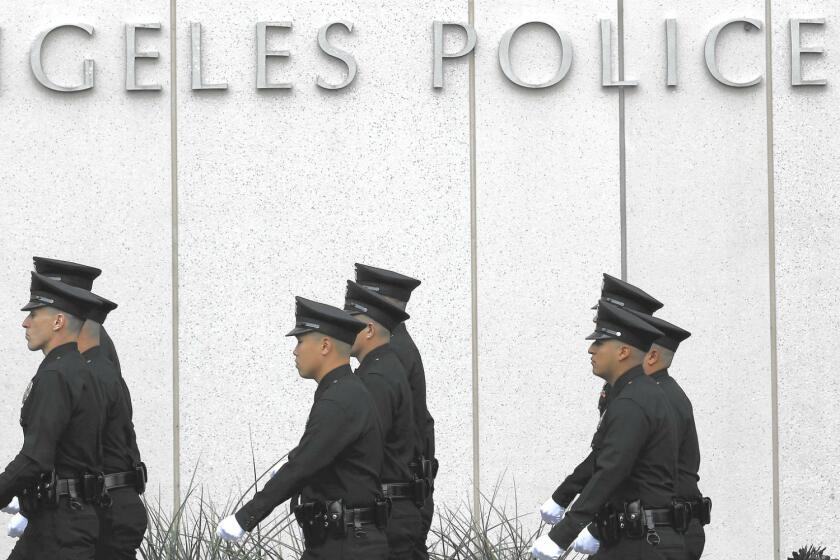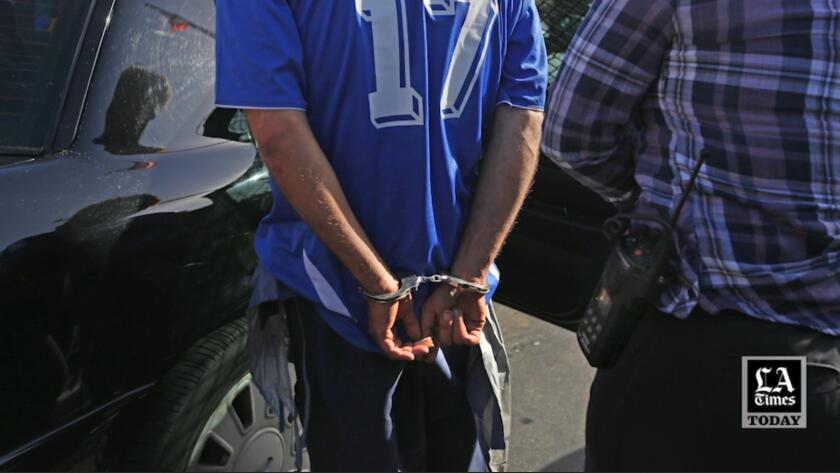(Jess Hutchison/Los Angeles Times)
- Share via
While campaigning for mayor in mid-August, Karen Bass spoke about a brand-new three-digit mental health crisis hotline — 988 — and its promise to save lives of people suffering from mental illness by avoiding deadly confrontations with police.
As a member of Congress, she had examined more than 100 lethal police encounters throughout the country and found that at least 40% involved a mental health crisis, she said. The figure dwarfs the often-cited national statistic that a quarter of all people who die at the hands of law enforcement have serious psychiatric problems.
In Los Angeles, police reported a similar figure in 2022: 39% of the people their officers shot were in the midst of a mental health crisis.
Now, that would change, Bass said at the news conference highlighting the launch of the 988 Suicide and Crisis Lifeline.
“I’m so proud to know that L.A. is going to be on the forefront of having a solution,” she declared.
In L.A., mentally ill people are cycled through what police, mental health officials and advocates agree is a revolving door of temporary psychiatric units and jail wards, never getting the long-term care they need.
But the rollout of 988 and related psychiatric emergency services has so far failed to live up to that promise, a Times investigation has found.
On July 15, 2022, one day before the 988 hotline went live, the L.A. County Department of Mental Health proclaimed the county was ready for a “seamless” rollout of the service that would include “trained psychiatric mobile crisis response teams who can be connected to through the 988 line when necessary.”
The county would hire privately contracted teams so crisis therapists could respond 24/7, up from 18 hours a day, the county statement said.
More than eight months later, none of that has come to pass: Hotline workers cannot directly dispatch mental health teams, and callers often wait hours for an emergency response.
Although the county mental health department has a fleet of mobile teams dedicated to responding to people in psychological distress, in more than 9 of 10 cases, those unarmed mental health workers take more than an hour to respond to callers in need of emergency services, a Times analysis of county data found.
About half of the time, teams take more than four hours; sometimes callers wait days.
Meanwhile, the phone and computer systems that city and county agencies use to help residents in crisis remain disconnected from 988.
Federal regulators are setting up a three-digit national number for a suicide prevention hotline to make it easier to seek help and to reduce stigma.
Crisis counselors who answer the 988 hotline — via the nonprofit Didi Hirsch Mental Health Services, based in West L.A. — cannot dispatch emergency teams. Instead, they must transfer a person in crisis to a separate county hotline, which can opt to send mental health workers — bouncing the caller around the system.
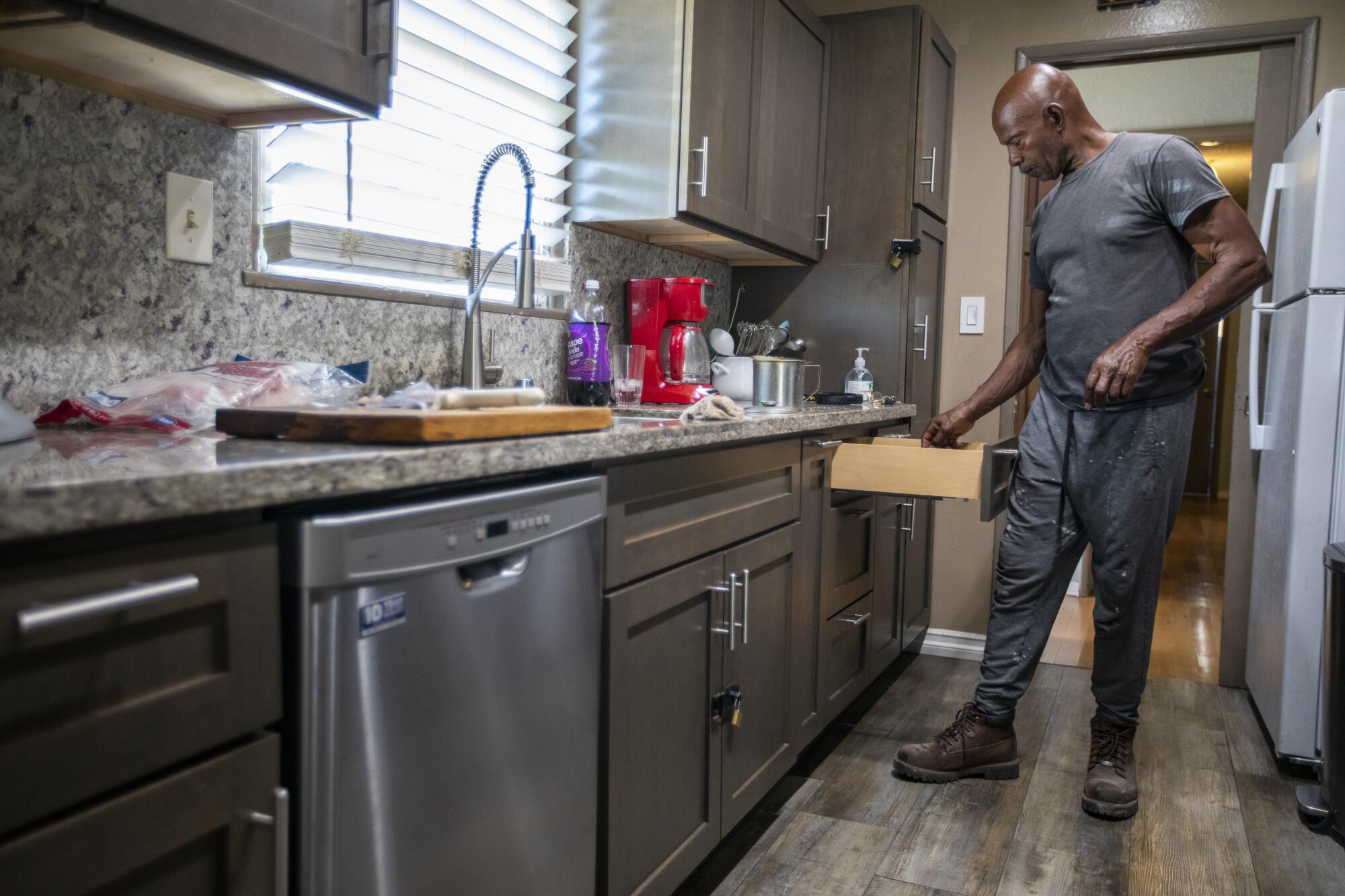
Sam Blake, who runs a home for people with severe mental illness in Sylmar, has pretty much given up requesting a mobile crisis team when a client becomes unstable or aggressive, which can happen weekly for residents with hard-to-treat disorders. He said teams usually take four to six hours to show up. The last time, they didn’t come at all.
“They’re too slow, and they’re not sufficient,” Blake said of the teams. “Our first choice now is either call the police or at least get the client to stop being destructive.”
A new way to show up: Sending therapists instead of cops
A person who breaks their leg, faces a robber at gunpoint or flees a house in flames can count on paramedics, police or fire personnel to rush to their aid. There is no equivalent in much of the U.S. to assist an individual battling psychological demons.
“That is what we are trying to change here in L.A. County,” Supervisor Janice Hahn said in a statement.
In Los Angeles, policymakers and law enforcement officials have long known that what’s in place wasn’t working. They began efforts to change the system years before the national 988 number came along.
Both the LAPD and Los Angeles County Sheriff’s Department pair mental health clinicians with specially trained officers in an effort to deescalate crises without using force. The law enforcement agencies began rolling out those specialized teams in the early 1990s. The county mental health department also began building its civilian mobile response more than two decades ago.
Calls to scale up these programs became more urgent in recent years, prompted by disturbingly frequent incidents of police killing people — particularly Black men — who were in the midst of mental health crises.
Police officials say such weapons represent real, imminent threats. Others claim the danger is exaggerated and that officers are too quick to pull the trigger.
Sharon Watkins, who fought for the passage of a state law that funds non-police local crisis responses, is keenly aware of that urgency.
On the night of Feb. 11, 2015, Watkins got a call that Phillip Watkins was talking about killing himself. Her 23-year-old son appeared to be having a psychotic break.
She drove furiously to get to the scene but was met with police tape.
The Santa Clara County District Attorney’s Office said Phillip ran toward two San Jose police officers with a folding knife, “intent on dying that day.” Seven bullets were found in his body. His mother said Phillip’s 2 ½-year-old daughter was in earshot of the guns going off.
“It’s hard to explain if you’ve never been through it, not to rush — and how important it is to get it right,” Watkins said of developing alternatives to police response. “Because to me, even one death is one too many.”
A breakdown in the system: waiting hours for someone to come
With the launch of the 988 hotline in mid-July, Los Angeles officials hoped to put in place a system to avoid such tragedies.
County officials don’t plan to completely remove police from responding to mental health crises. Instead, they aim to reduce and refine law enforcement’s role so they respond only in the most dangerous or volatile situations.
That goal has support from a wide range of groups involved in the system. In March, the largest Los Angeles Police Department employees union said it would seek to have officers stop responding to mental health calls in which there is no threat of violence or criminal activity.
“I don’t think there’s ever going to be a situation where we can say law enforcement is not going to be” involved, said Jennifer Hallman, alternative crisis response manager for the mental health department. “But we want to make sure that we minimize that, right — that it’s not law enforcement just because they can get there faster or it’s what people know to do.”
A shift to civilian response, however, requires having someone else who can rapidly show up when residents need in-person help, as well as agreement on how to gauge the severity of calls.
Instead, the in-person piece of the puzzle — the number of civilian response teams — has remained stubbornly stagnant even as the volume of people calling the 988 hotline has grown and the focus of the call centers has broadened, bolstered by an infusion of what’s risen to nearly $1 billion by the federal government.
For the record:
1:06 p.m. April 13, 2023A previous version of this story reported there were 13 call centers in California. A Yolo County center stopped fielding 988 calls in February, lowering the number to 12.
Services at the roughly 200 centers scattered across the country — including 12 in California — have expanded from primarily providing suicide prevention to soothing an array of mental health issues, including substance use problems and advice on how to help a loved one in crisis. Only a fraction of those calls require an emergency response.
Didi Hirsch Mental Health Services, which handles 988 calls from Los Angeles, Orange, Riverside, San Bernardino, Ventura, Imperial and Inyo counties and is also the lead agency for the state, reported a 22% jump in calls, texts and chats in the first six months since the launch. The call center has also grown, bringing on an additional 106 volunteers and 77 staffers.
The 988 Suicide and Crisis Lifeline launched in mid-July. We want to hear about your experiences using it.
In a step toward meeting the increased need, the mental health department modified two contracts last year — one in August, one in December — to expand its fleet of 33 civilian mobile crisis teams. But only two contracted teams are up and running — bringing the total to 35. The hours of operation haven’t budged, with teams available from 8 a.m. to 2 a.m.
The county would require 138 teams within the next few years to meet the needs of its 10 million people spread across 4,753 square miles, according to a report by an outside consultant assessing the system’s needs.
The county’s current goal is to scale up to 60 teams by the end of the year. Three are expected to begin operating this month, said Lisa H. Wong, director for the L.A. County Department of Mental Health.
“This capacity will allow us to provide 24/7 coverage as well as reduce response times so those experiencing a mental health crisis can receive timely care,” Wong said in a statement.
The inability to hit those goals so far is not due to a lack of money: The department is budgeted for about 50 teams for the current fiscal year, according to a January report. The county Board of Supervisors has invested $152 million in state and federal funding into beefing up its alternative crisis system, including expanding its mobile crisis teams and call center services, according to a recent motion.
County officials say it’s been difficult to hire for work that requires clinicians to leap into the field — including during weekends and all hours of the night — to treat some of the sickest residents.
The county’s Department of Mental Health says people declined or left positions for various reasons during the pandemic, including the opportunity to work full time in telehealth. But the county says it’s beginning to see a rebound in interest.
Since the COVID-19 pandemic prompted many therapists to transition to telehealth, clinicians can opt to work from home, making hiring for field jobs even harder.
Since COVID, “it has become a challenge to hire staff because competition out there is pretty high,” said Miriam Brown, deputy director for the emergency outreach and triage division at the mental health department. “I myself, I’m a licensed clinical social worker, I get a lot of offers left and right.”
County leaders anticipated this problem ahead of the 988 launch, “so we sped up the hiring process and offered bonuses and loan forgiveness,” said Hahn, who represents the county’s Fourth District. “This hasn’t been enough.”
Supervisors Hahn and Kathryn Barger authored a motion, approved earlier this month, calling for the creation of a pilot program to explore additional incentives.
“We can only be successful in our efforts if we have enough teams to respond when and where they are needed,” the supervisors said in their motion. “We must do everything we can to fill these positions.”
Why the police show up faster: a history of delays
Response times for the county’s psychiatric mobile crisis teams have worsened since the start of the pandemic, according to data analyzed by The Times. In 2019, about 10% of teams dispatched took more than eight hours to respond. That number ballooned to 34% in 2022.
How we analyzed the data
The Times examined psychiatric mobile response team data from 2019 to 2022 provided by the L.A. County Department of Mental Health. The analysis measured the time from the county staff‘s request for a team to its arrival on site. There were roughly 20,000 requests per year between 2019 and 2021, dipping to about 17,800 requests in 2022.
Several thousand incidents were excluded from the analysis because county officials indicated they likely reflected clerical errors. Others were excluded because the dispatch might have been canceled, including cases in which a caller said help was no longer needed. A county spokesperson said response times may be affected by other factors, such as situations where the caller postponed the team’s arrival or when the client was no longer at the scene.
The pandemic decimated resources as people fell ill or burned out of the workforce, slowing down response, according to the county mental health department. In some cases, mobile crisis workers waited hours with patients until ambulances, facing similar shortages, arrived to transport patients to hospitals, department officials said.
Even before the pandemic, however, wait times were staggering: In 2019, nearly 88% of dispatched teams took longer than the goal of one hour to respond, while 25% took longer than 4 hours.
By contrast, the Sheriff’s Department’s 34 Mental Evaluation Teams took about 18 minutes on average in 2021 to arrive, according to Capt. John Gannon, who previously oversaw the units.
Those who use, work in and oversee the crisis system have long been aware of how slow the civilian teams are. Yet as of October, officials with the mental health department said they were not routinely tracking or analyzing data.
Department officials said they improved their dispatch processes in February and are working with labor unions on ways to speed up mobile crisis interventions.
The inadequacy of the civilian response has created a vacuum filled by other emergency services — typically law enforcement.
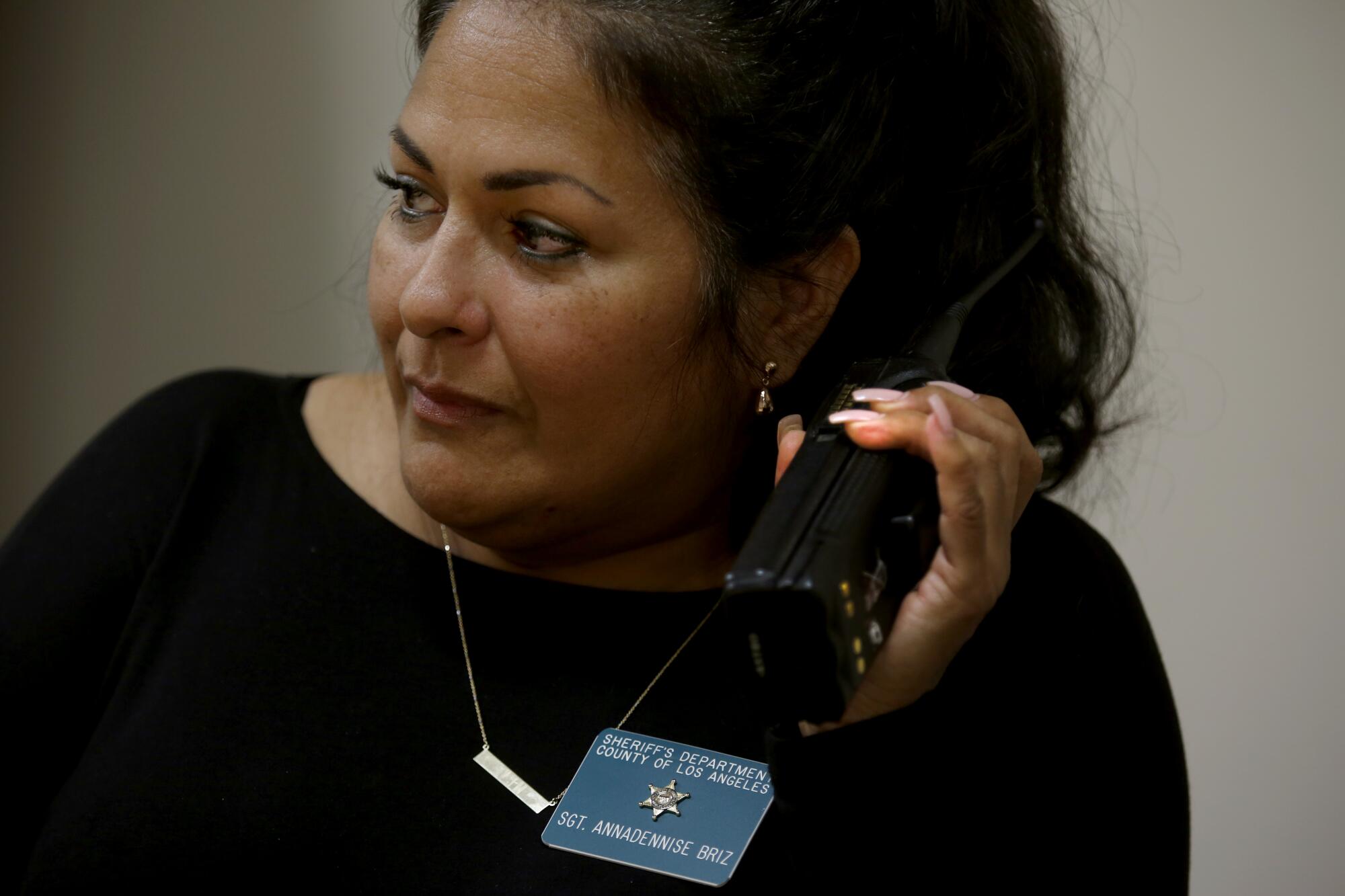
When a family calls for help, it means they’re afraid of a bad situation, said Lt. Annadennise Briz, a former county mental health clinician who leads the Sheriff’s Department’s Mental Evaluation Team. Families in crisis typically can’t wait hours for a civilian team to arrive.
“To keep the family from living in fear until [the civilian team] gets there, they will call us and we will go out,” she said.
A long endgame amid an urgent crisis
Proponents of the 988 system stress that it’s in its infancy and will take time, effort and money for reality to match the long-term vision of transforming the nation’s crisis response.
Developing a policy and financing framework for the new system will be a lengthy process, in California and across the country, said Michelle Doty Cabrera, executive director of the County Behavioral Health Directors Assn. of California.
“There’s the downstream ambitious goal or vision that some people have, that 988 will be that portal and that conduit to connect people to something much more, and then there’s the sort of work that we need to do to build out toward something like that,” Cabrera said. “I would say that there are still a lot of gaps to establish 988 as that conduit or portal — and that’s OK.”
In the interim, however, people with serious mental illnesses continue to die in confrontations with police.
Friends and relatives of Takar Smith gathered Tuesday outside the apartment building where the 40-year-old father of six was shot while struggling with LAPD officers, one of two fatal police shootings to start 2023.
Less than five months after the news conference at which Bass lauded 988, LAPD officers called to a Westlake apartment fatally shot Takar Smith, a father of six who was diagnosed with schizophrenia.
Officers huddled outside of the apartment didn’t loop in LAPD’s Mental Evaluation Unit when planning how to respond — although his estranged wife, Shameka Smith, had mentioned several times on her call to police that he hadn’t been taking medication to treat his psychotic disorder.
“I begged them not to shoot him,” she said.
This article was produced as part of the USC Annenberg Center for Health Journalism‘s 2022 Data Fellowship and engagement initiative.
- Share via
Watch L.A. Times Today at 7 p.m. on Spectrum News 1 on Channel 1 or live stream on the Spectrum News App. Palos Verdes Peninsula and Orange County viewers can watch on Cox Systems on channel 99.
More to Read
Sign up for Essential California
The most important California stories and recommendations in your inbox every morning.
You may occasionally receive promotional content from the Los Angeles Times.

